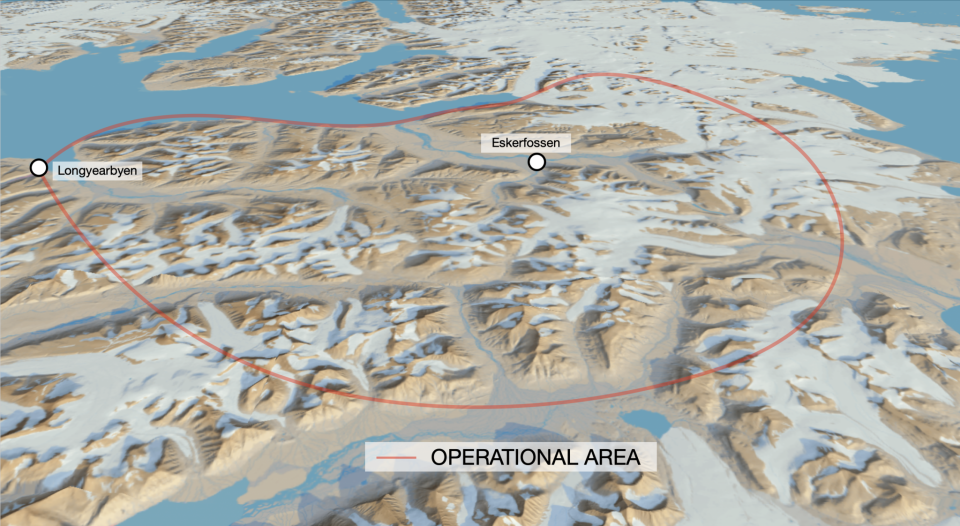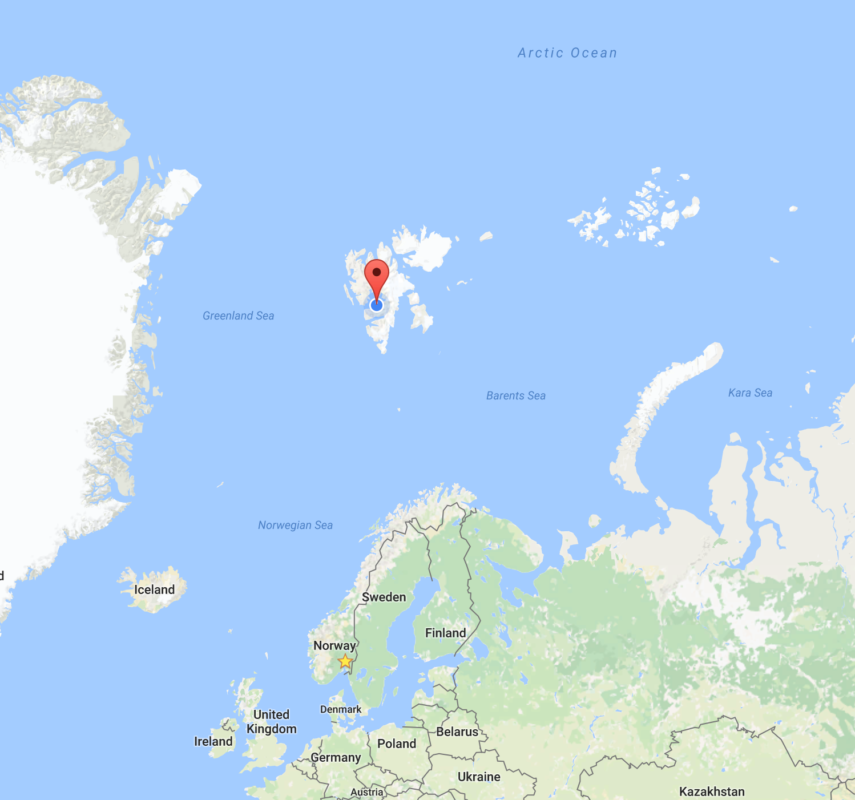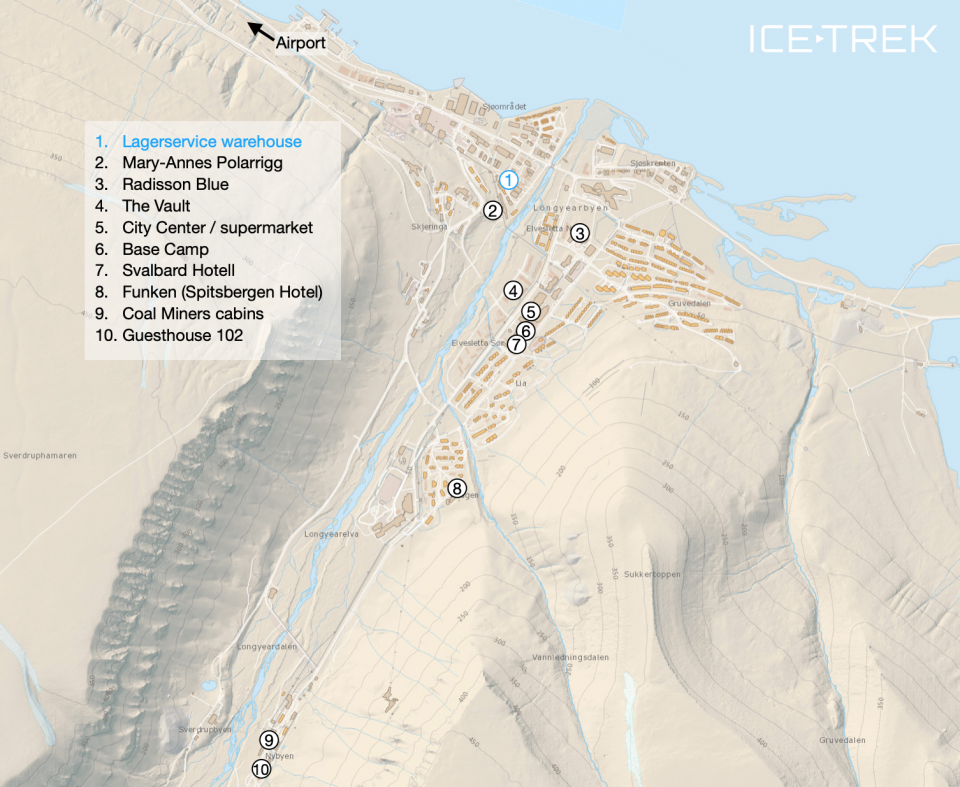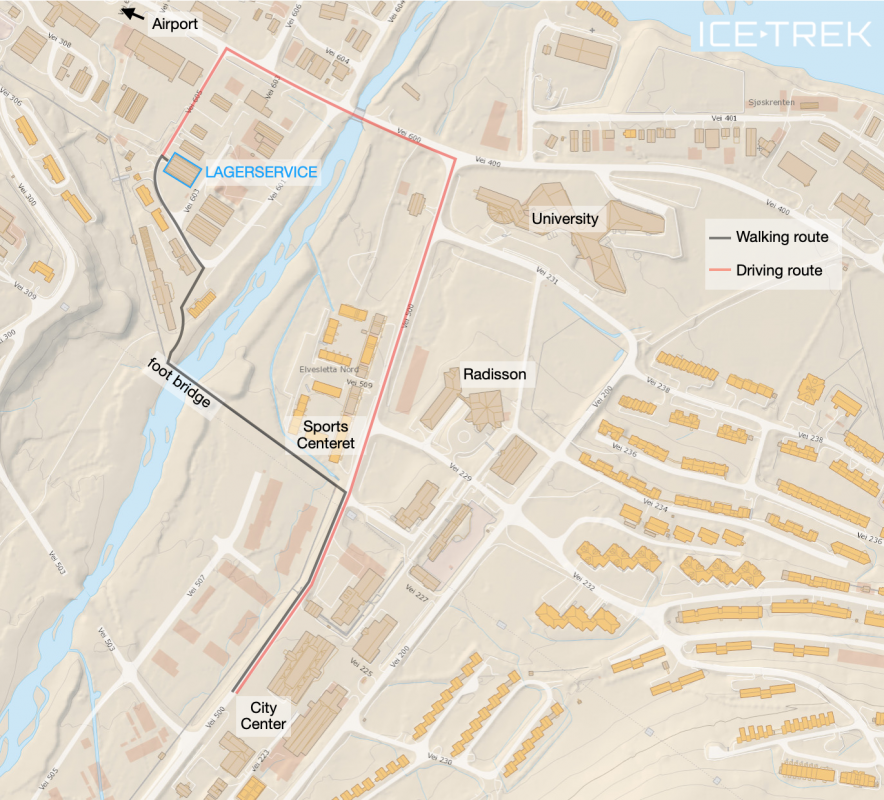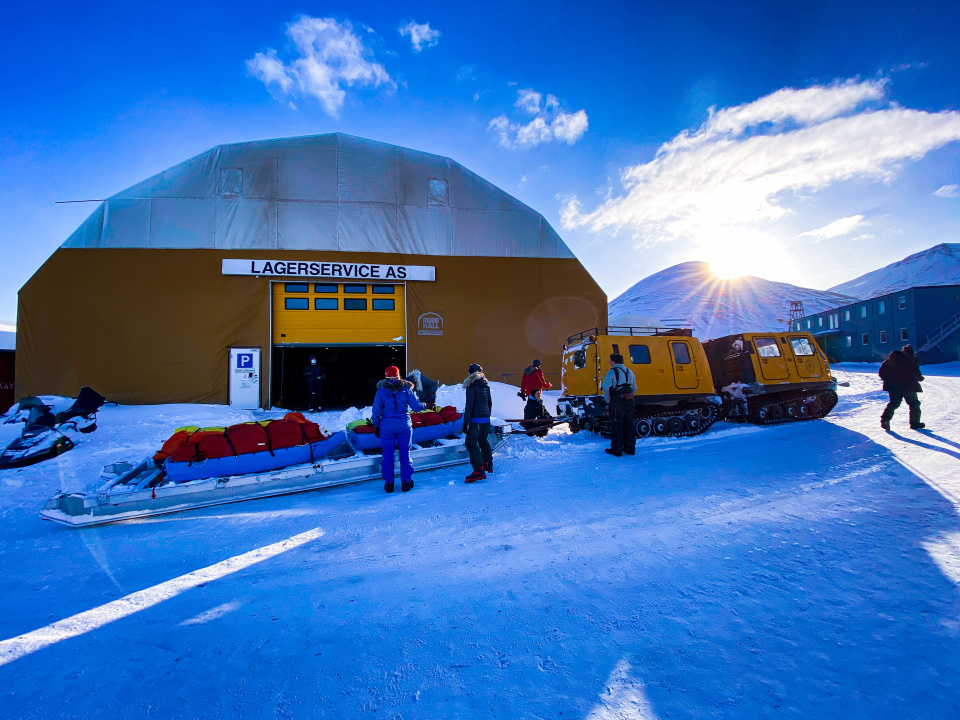Practical polar expedition training.
This practical training program primes you for any polar ski expedition, in Antarctica, Greenland or Svalbard itself. It covers the basics of polar equipment, navigation, diet and daily schedules, as well as being a rewarding adventure across the icescapes of Spitsbergen.
- Gateway Longyearbyen, Norway
- Distance varies
- Days on Ice 5
- Daily Distance varies
- Temp. Range -10 to -35°C
- Sled Weight 35kg
- Challenge 4 What's this?
- Conditions Cold, wind
- Challenges Cold management, sled hauling, long ascents and descents
Trip Itinerary
Meet at Lagerservice warehouse at 4pm with your expedition clothing and equipment (see Getting There).
You require accommodation in Longyearbyen for this night.
Tutorials on stove lighting and tent pitching, food packing, ski practice.
You require accommodation in Longyearbyen for this night.
Bus shuttle to edge of town, begin trip.
Skiing, sled hauling and camping. We will remain at the same location for the last two nights, doing a day trip onto a glacier with light sleds.
Ski to the outskirts of Longyearbyen and bus shuttle into town, end of trip.
(You will require hotel accommodation unless you fly out immediately. Do not book a flight out earlier than 2pm if you want to depart the same day)
Inclusions
- Transport to expedition start point
- Transport at end of trip
- Food and stove fuel while on the ice
- Icetrek guide(s)
- Use of technical equipment including sleds, skis, tents, sleeping bags, cooking equipment. This equipment is returned to Icetrek after the trip (see equipment list)
- Safety/navigation/communications equipment
- 20% discount on selected Icetrek Equipment
- End of trip celebration drinks!
Exclusions
- Meals and accommodation in Longyearbyen (you require 1 or 2 nights accommodation at the beginning of the trip and another at the end if you decide to stay the night)
- Additional costs (accommodation, meals etc.) due to changes beyond our control ie. weather delays
- Evacuation, hospitalization and repatriation costs and/or insurance
- Personal clothing and footwear
You don't need any prior polar, skiing or winter camping experience to join this trip. Svalbard Polar Primer is an introductory adventure that introduces you to the Arctic environment and how to skilfully survive, camp and move across it.
We meet in Svalbard’s capital Longyearbyen, on the island of Spitsbergen (Norway) the night before our departure, however if you have time we suggest you arrive even earlier to allow time to discover the town and acclimatise to the conditions. Starting with the basics while still in Longyearbyen - tent pitching, stove lighting, sled packing, food preparation, clothing and equipment use - we then progress onto the ice, spending a half day on skis hauling sleds to our first camp in a broad, protected valley. Everything is slowed down to give you time to settle into life on a polar expedition and we help you to get a sturdy, organised and safe camp set up.
Over the next 5 days (4 nights) we ski through a classic polar environment where snow and ice rule the vista. Frozen valleys, mountains and glaciers abound and we traverse all types of terrain, developing skills and confidence in polar expeditioning. Covering large distances is not an objective of this program; becoming accustomed to the cold, learning to manage safe polar adventuring, setting up a safe camp, learning to operate a stove and learning how to move efficiently across the ice is our aim. You will develop a growing comfort in the polar environment, increasing confidence in your skills and a readiness to move to the next level if that's your interest. And if it's not, then this trips is also the perfect standalone experience to give you an appreciation of our world of polar adventure.
We wake at 6am to maximise our usable hours. First thing we do is light the stove to bring some warmth to the tent and begin heating water for breakfast and drinks. We also make sure that our thermoses are topped up with boiling water. A quick look outside reveals the perimeter wire connected to flares, our alert system for polar bears, and beyond a magnificent landscape of sharp snow-capped mountains, and the glacier upon which we are camped.
By 8.30 we are ready to go with sleds packed, skis on and a sturdy climb into the mountains ahead of us. We travel in single file, the trail-breaker (usually the guide) doing most of the work, the team following in the tracks to conserve energy. And if you want to lead the group for a while we fully encourage it, in safe and uncomplicated terrain. In spring most of the glacier’s crevasses are filled in and pose no problem, but we always carry glacier travel equipment if the need arises to rope up.
On skis we continue up the glacier, watching as peaks emerge into view, come alongside and recede onto the skyline. Soon we are at the top of the glacier and on snowfields that undulate into the horizon. A quick break to drink from our thermoses and eat from our snack bags before we find our stride once again and lock into the polar plod, listening to the glide of our sleds, the swish of our skis and the rhythm of our hearts. Everything is in sync.
Lunch is a scenic spot overlooking a frozen fiord. We sit on our sleds or foam seats, eating hot ramen noodles, cheese, salami and crackers and a collection of nuts, dried fruit and chocolate. We never go hungry.
The afternoon brings some additional excitement as we reach a pass between the mountains after which we can straddle our sleds, skis on either side, and toboggan down a long slope. The ride is exhilarating as we glide down the incline, using the ski edges to steer and the rope traces thrown under the sled as a quick brake if needed.
Down in a broad valley we pass fox tracks and see small herds of reindeer grazing on invisible grass. Polar bear sightings are rare but we are always prepared, armed with flare guns and firearms. It is not permitted to travel in these areas without them.
The mountains lining the valley now obscure the sun and the temperature drops a few degrees as we march through the giant shadows. An hour later we ski into the fading light, our shadows long and golden across the valley floor. In the last light we set up our camp, securing the shelters to the ice and snow using tent stakes and ice screws, and shoveling snow onto the tent flaps to prevent any drift snow entering the tent layers. The guide rigs up the perimeter wire and we climb into our tents to light the life-giving stoves. Slowly the interior gains some order as mattresses, sleeping bags, kitchen and belongings find their place. Soon enough we are enjoying a hot soup followed by dinner and some saved chocolate.
Something you will never be short of on an Icetrek polar expedition is sleep, we allocate a minimum of 8 hours every night so that you recover adequately for the day ahead. A weather forecast predicts light winds and blue sky, another perfect day in paradise. Sweet dreams!
Flights
There are flights with SAS and Norwegian Air almost daily from Oslo, Norway to Longyearbyen. Flights are not included in the price.
Visa
A visa is not required for Svalbard.
Arrival
When you arrive at Longyearbyen airport you can either take a taxi or the shuttle bus to your hotel, both accept credit cards. If you are staying at an AirBnB tell the driver the address or show him a map of the location and you will be dropped at the nearest hotel or convenient location.
Accommodation
Accommodation in Longyearbyen is not included in the price. There are many hotel and hostel options and some AirBnB’s. Use your preferred accommodation booking service to find the wide range of establishments in Longyearbyen. Some popular options include:
Radisson Blu - close to town centre, 5 minutes walk to warehouse where we prepare
Funken - 10 minutes walk from town, 20 minutes walk from warehouse
Svalbard Hotell/Lodge/Vault - in town, 10 minutes walk from warehouse
Mary Anne’s Polarriggen - 10 minutes walk from town, next to warehouse
Coal Miners’ Cabins - 15 minutes walk from town, 25 minutes walk from warehouse
Guesthouse 102 - next door to Coal Miners’
How to find Lagerservice warehouse
WHAT IS SVALBARD POLAR PRIMER?
Svalbard Polar Primer is a 5-day introductory ski and sled hauling expedition on Spitsbergen, the largest island in the Svalbard archipelago. It occurs in spring when the fiords are frozen and the mountains and glaciers are covered in a thick later of snow.
.
What will I learn on the Svalbard Polar Primer?
You don't need any prior polar, skiing or winter camping experience to join this trip. Svalbard Polar Primer is an introductory experience that introduces you to the Arctic environment and how best to survive, camp and move across it.
We start with the basics while still in Longyearbyen - tent pitching, stove lighting, sled packing, food preparation, clothing and equipment use - then progress onto the ice, spending a half day on skis hauling sleds to our first camp in a broad, protected valley. Everything is slowed down to give you time to settle into life on a polar expedition and we help you on the first evening to get a sturdy, organised and safe tent set up.
Over the next 4 days you will develop skills and confidence in polar expeditioning. Covering large distances is not an objective of this program, but slowly building time in the sled harness is, until you feel comfortable in the environment, confident in your growing skills and ready to move to the next level if that's your interest. And if it's not, then this trips is also the perfect standalone experience to give you an appreciation of our world of polar adventure.
.
Can I leave bags in Longyearbyen?
Yes. We have a secure storage facility in Longyearbyen where you can leave bags.
.
Where do we meet?
We meet at Lagerservice warehouse at 4pm, two days before the strat of your trip (see Getting There).

.
What will be the temperature on arrival in Longyearbyen and during the trip?
The temperature will be anywhere from -10 to -20C, 14 to -4F
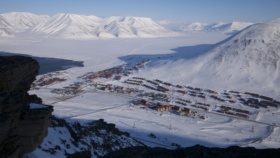
.
How heavy will my sled be?
For the Svalbard Primer program your sled will be 35 to 40 kg, 77 to 88 lb.
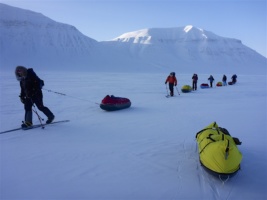
.
What if I am not a skier?
Many of our Svalbard Primer customers have never been on skis before. We will train you at a manageable pace while you are on the ice.
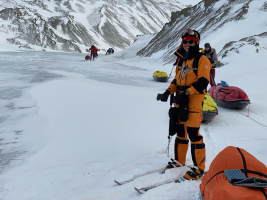
.
What is the Guide to Client ratio?
1:5
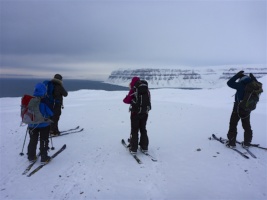
.
Will there be any crevassing?
Svalbard glaciers are crevassed though this time of year they are still mostly filled in with snow. However we always carry glacier travel equipment - ropes, harnesses, rescue gear - and use it when necessary.

.
What type of sleds do we use?
We use Icetrek Nilas and Polynya sleds made from slippery HDPE plastic. These are purpose designed and built by us to give optimal performance on ice and snow.
.
What type of tents do we use?
We use Hilleberg Keron 4-person tents for two people and a Hilleberg Altai group tent. There is plenty of room to get comfortable but small enough to warm up quickly once the stove is operating. You are responsible for setting up, managing and taking down your tent.
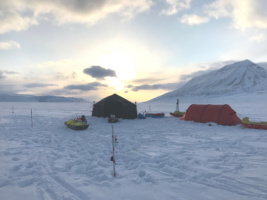
.
What type of sleeping bags and mattresses do we use?
We provide you with a roomy synthetic outer sleeping bag to use over the top of your 4-season down sleeping bag. The combination will be rated to -40. We also provide an inflatable and foam mattress combination with a minimum 6+ R-Value. We also provide you a protective mattress sleeve that converts to a chair to sit up and rest comfortably in the tent.
.
What will we eat on the expedition?
You can find our menu here
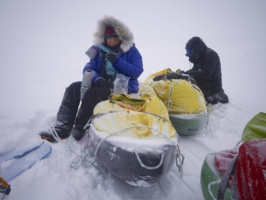
.
Who cooks the meals and melts the snow for water?
You do! This is a normal part of expedition life. We train you in how to use the stove.
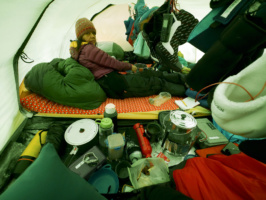
.
What if there is an emergency and how will we communicate with the outside world?
We carry an Iridium handheld phone and an Iridium modem, we can use both to call services in Longyearbyen and post daily updates and images to our Iceblog. We also carry a tracking beacon with emergency function and a Personal Locator Beacon which can be activated in an emergency. Signals from both are received by emergency services and relayed to Longyearbyen rescue services. We are also in mobile range for much of the trip.
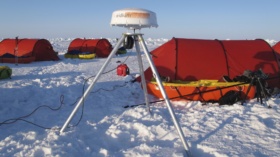
.
How long do we ski every day on the Svalbard Primer trip?
We start gently, skiing for around four hours on the first day. We cover this by skiing one hour, then have a short stand-up break, then another hour with a sit down break. We do the same again and have lunch and then another 2 hourly sessions before camping. When everybody feels ready we might extend to 7 and perhaps eight hours per day.
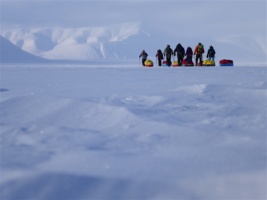
.
Where can I find more information about Svalbard Polar Primer?
Once you have signed onto the trip you will receive a Svalbard Trip Information Booklet which has full details of how to plan for your trip.
*
Feel free to submit your own questions.
